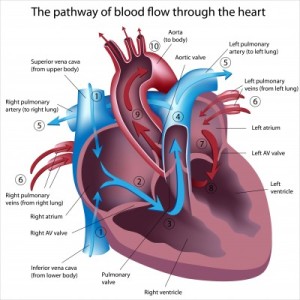CBET Review: Anatomy of the Heart

As the fall CBET exam window creeps up on us, aspiring CBETs need to get smart about how and what to study. When I was preparing for the CBET exam, I made sure that I memorized all the easy information about subjects that I knew would pop up in the test. The Heart is one of those things that you just need to know about because you are bound to come across a question or two about it in the CBET exam.
Listed below are the key points to know about the heart:
Main function of the Heart:
- To circulate blood throughout the body with its pumping action. (Duh!…No seriously, everyone should know that.).
Layers of Heart tissue:
- The upper layer of Heart tissue is called the Pericardium.
- The middle layer f Heart tissue is called the Myocardium.
- The innermost layer of Heart tissue is the Endocardium.
Chambers of the Heart:
- The Heart has 4 chambers. Two in the top and 2 in the bottom. The top chambers are called Atria (plural for Atrium) and the bottom chambers are called Ventricles.
- The Atria are divided by the Interatrial Septum and the ventricles are divided by the Ventricular Septum.
- The Atria collect blood and the ventricles eject blood from the Heart.
Valves of the Heart:
- The valve between the Right Atrium and Right Ventricle is called the Tricuspid Valve or Right AV valve.
- The valve between the Left Atrium and Left Ventricle is called the Mitral Valve or Left AV Valve.
- The valve of the Coronary Sinus is called the Thebesian Valve.
- The two semilunar valves are on the arteries leaving the heart which are the Aortic Valve and the Pulmonary Valve.
Blood flow through the Heart:
- The Right side of the Heart (Right Atrium and Right Ventricle) deal with deoxygenated blood.
- The left side of the Heart (Left Atrium and Left Ventricle) deal with oxygenated blood.
- Deoxygenated blood enters the Heart via the Superior Vena Cava, Inferior Vena Cava and the Coronary Sinus to the RIGHT ATRIUM it is then pushed in to the RIGHT VENTRICLE. Blood is then forced out of the right ventricle it passes through the pulmonary artery to the lungs and alveoli to oxygenate. It then comes back to the LEFT ATRIUM via the Pulmonary Vein then it is pushed into the LEFT VENTRICLE which then pushes the oxygenated blood back to the body via the AORTA.
Electro-Conduction System of the Heart:
- The Heart’s natural pacemaker is called the SA Node or Sino Atrial Node.
- The Sodium-Potassium Pump Phenomenon is what causes the difference in potential.
- Heart beats that do not originate at the SA Node are referred to as ectopic beats.
- The P wave represents atrial depolarization.
- The QRS complex corresponds to the depolarization of the Left and Right Ventricles.
- The T wave represents ventricular repolarization.
- The path of the Electro conduction system of the heart follows this route: The beat originates at the SA Node then to the AV node then to the Bundle of His then to the Bundle branches and then the Perkinje fibers.
By no means does this article cover all the aspects of the heart and as you can see, the Heart is a very intricate organ, however with a little practice and studying you can make sure that you get any question about the heart on the CBET exam correct!
P.S. Please leave comments and feedback!
Manuel Jimenez, BEET, CBET

